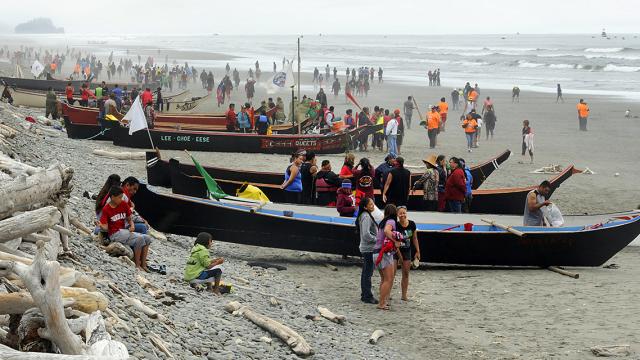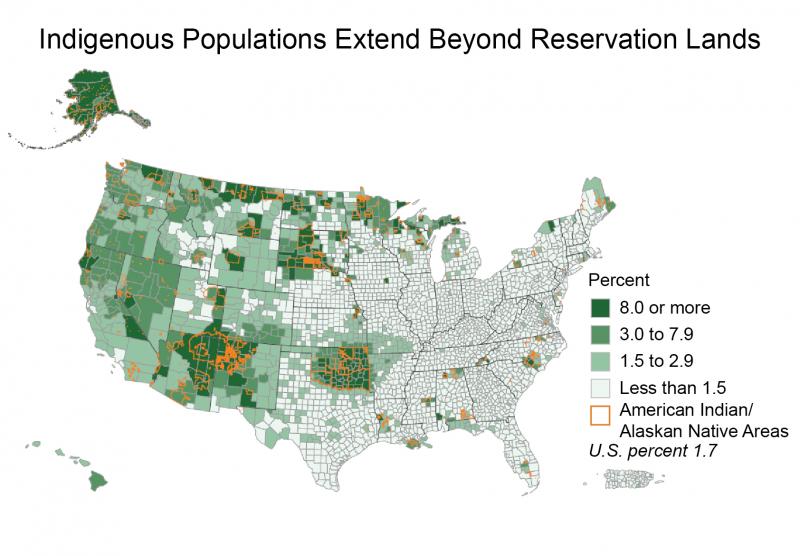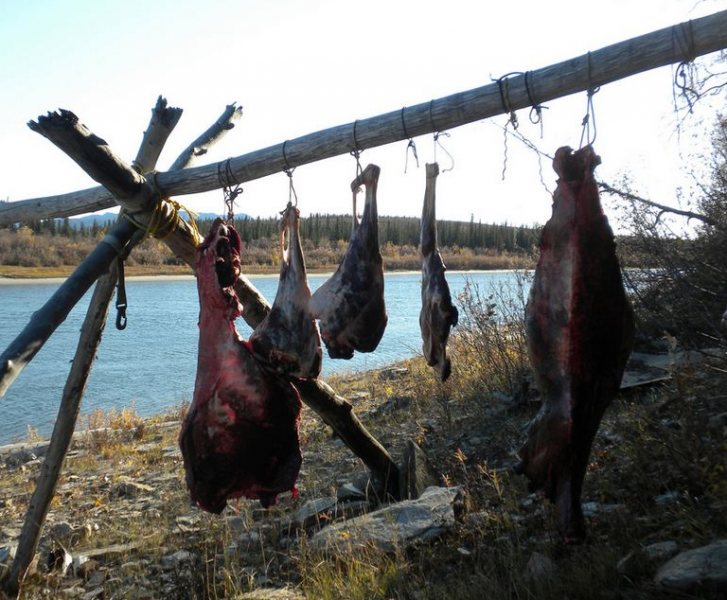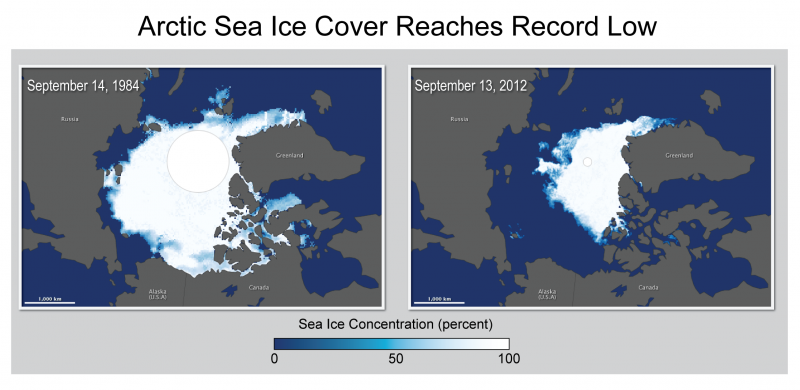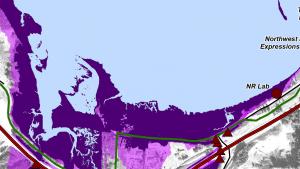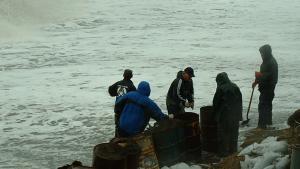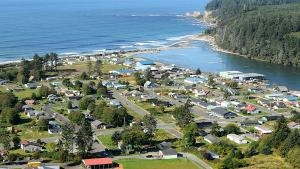Chronic stresses such as extreme poverty are being exacerbated by climate change impacts: these impacts include reduced access to traditional foods, decreased water quality, and increasing exposure to health and safety hazards. In Alaska, Maine, the Pacific Northwest, and other coastal locations, erosion and inundation related to climate change are so severe that some communities are already relocating from historical homelands to which their traditions and cultural identities are tied.
Loss of traditional foods
Climate change impacts Tribal Nations' access to traditional foods. Fare such as salmon, shellfish, crops, and marine mammals have provided sustenance as well as cultural, economic, medicinal, and community health for countless generations. Some plants used for medicines and food are becoming increasingly difficult to find, or are no longer found in historical ranges.
Subsequent shifts from traditional lifestyles and diet—compounded by persistent poverty, food insecurity, the cost of non-traditional foods, and poor housing conditions—have led to increasing health problems in native communities. Climate change is likely to amplify other indirect effects to traditional foods and resources, including limited access to gathering places, hunting grounds, and environmental pollution.
A key uncertainty is how indigenous people will adapt to climate change, given their reliance on local, wild foods and the geographic isolation of some communities. For example, increased wildfire frequency and intensity due to fuel loading brought on by drought and other factors may affect tribal homes, safety, economy, culturally important species, medicinal plants, traditional foods, and cultural sites. Additionally, tribes have varying levels of preparedness and some have a limited ability to cope with extreme events.
Impacts on ecosystems and water quality and quantity
Climate change also affects the integrity and stability of the ecosystems on which indigenous peoples depend by altering ecosystem processes and biodiversity. Ecosystems provide a rich array of benefits and services including habitat for fish and wildlife, drinking water storage and filtration, fertile soils for growing crops, buffering against a range of stressors, and aesthetic and cultural values. Changes in these resources have social, cultural, and economic effects on native communities in particular. Events such as droughts, floods, wildfires, and pest outbreaks associated with climate change (for example, bark beetles in the West and Alaska) are already disrupting ecosystems. In the longer term, there is increasing risk of species extinction, which could be particularly devastating to native communities reliant on specific species for food, medicine, and ceremonies.
Decreases in water quality and quantity are affecting Native Americans' drinking water supplies, food, cultures, ceremonies, and traditional ways of life. Native communities’ vulnerabilities and lack of capacity to adapt to climate change are exacerbated by historical and contemporary federal and state land-use policies and practices, political marginalization, legal issues associated with tribal water rights, water infrastructure deficiencies, and poor socioeconomic conditions.
Extreme impacts on Alaska Native communities' way of life
Scientists across the Arctic have documented regional temperatures over the past few decades rising at twice the global average rate, and indigenous Arctic communities are observing this change in their daily lives. Trends of increasing temperatures and variable precipitation patterns are expected to continue with future climate change. The cascading effects of these changing conditions are illustrated by significant reductions in sea ice thickness and extent, increased permafrost thaw, more extreme weather and severe storms, changes in timing of seasonal ice melt/freeze of lakes and rivers, water temperature, sea level rise, flooding patterns, erosion, and snowfall timing and type. For more information, tools, and case studies specifically addressing Arctic climate impacts, also see this Toolkit's Arctic topic.
In turn, these climate-driven changes increase the number of serious problems for Alaska Native populations. Issues include injury from extreme or unpredictable weather and thinning sea ice, which can trap people far from home; changing snow and ice conditions that limit safe hunting, fishing, or herding practices; malnutrition and food insecurity from lack of access to subsistence food; contamination of food and water; increasing economic, mental, and social problems from loss of culture and traditional livelihood; increases in infectious diseases; and the loss of buildings and infrastructure from permafrost erosion and thawing.
The increased thawing of permafrost (permanently frozen soil) along the coasts and rivers is an especially potent threat to Alaska Native villages because it causes serious erosion, flooding, and destruction of homes, buildings, and roads from differential settlement, slumping, and/or collapse of the underlying base. As of April 2015, more than 30 Native Villages in Alaska are either in need, or are already in the process, of relocating their entire village. In addition, permafrost thaw is causing food insecurity in Alaska Native communities due to the thawing of ice cellars or ice houses used for subsistence food storage. This thawing can lead to food contamination and sickness, as well as dependence upon more expensive, less healthy, non-traditional “store-bought” foods. To learn how some North Slope Inupiat are adapting to this challenge, see the case study Inupiaq Work to Preserve Food and Traditions on Alaska's North Slope.
The preceding text was excerpted and adapted from the report Climate Change Impacts in the United States: The Third National Climate Assessment (Chapter 22: Alaska).
Traditional knowledges
Indigenous traditional knowledges (TKs) have emerged in national and international arenas as rich information for indigenous and non-indigenous climate assessments, policies, and adaptation strategies. With this growing recognition, however, comes potential risks to indigenous peoples in sharing TKs in federal and other non-indigenous climate change initiatives. Traditional knowledges have been defined as “a cumulative body of knowledge, practice, and belief, evolving by adaptive processes and handed down through generations by cultural transmission, about the relationship of living beings (including humans) with one another and with their environment.” Traditional knowledges are emergent from the symbiotic relationship of indigenous peoples and places—a nature-culture nexus. Tribes and indigenous peoples use “knowledges” to emphasize that there are diverse forms of traditional knowledge and knowledge systems that must be recognized as unique to each tribe and knowledge holder. From an indigenous perspective, traditional knowledges encompass all that is known about the world around us and how to apply that knowledge in relation to those beings that share the world.
Native cultures are directly tied to native places and homelands, reflecting the indigenous perspective that includes the “power of place.” Many indigenous peoples regard all people, plants, and animals that share our world as relatives, rather than resources. Language, ceremonies, cultures, practices, and food sources evolved in concert with the inhabitants, human and non-human, of specific homelands. The wisdom of native people includes songs, dances, art, language, science, and music that reflect these places. By regarding all things as relatives—not resources—natural laws dictate that people care for their relatives in responsible ways. As climate change increasingly threatens Tribal Nations, cultural identities, and practices, documenting the impacts on traditional lifestyles may strengthen adaptive strategies.
Featured Tools
Guidelines for Considering Traditional Knowledges in Climate Change Initiatives
In 2014, the Climate and Traditional Knowledges Workgroup developed Guidelines for Considering Traditional Knowledges in Climate Change Initiatives. These Guidelines examine the significance of traditional knowledges in relation to climate change and the potential risks to indigenous peoples in the United States for sharing traditional knowledges in federal and other non-indigenous climate change initiatives. The Guidelines include an annotated bibliography to provide access to research that addresses ongoing issues surrounding the protection and use of traditional knowledges, including appropriation of Indigenous cultural and intellectual property and the development of research protocols to ensure just collaboration between traditional knowledge holders and researchers. The site also includes a link to Climate Change and Indigenous Peoples: A Primer, which provides tribal perspectives on foundational information on policy and historical information relevant to climate impacts on indigenous peoples. The Guidelines and Primer, as well as training and workgroup activities, have been combined into an indispensable Guidelines for Considering Traditional Knowledges in Climate Change Initiatives tool to enhance all assessment, planning, and adaptation activities involving tribes and partners.
Featured Tribal Nations Tools for the Steps to Resilience
① Explore Hazards
- Guidelines for Considering Traditional Knowledges in Climate Change Initiatives
- Local Environmental Observer (LEO) Network
② Assess Vulnerability & Risks
③ Investigate Options
④ Prioritize & Plan
- Adaptation Workbook for Land Management and Conservation
- Climate-Smart Conservation: Putting Adaptation Princples into Practice
⑤ Take Action
Combining ways of knowing to adapt
Recent examples where traditional knowledges and new approaches are used together to address climate change and related impacts include:
- The Alaska Native Tribal Health Consortium Local Environmental Observers (LEO) Network chronicles climate change impacts on the landscape and on human health and also develops adaptation strategies. This Consortium employs interdisciplinary science, traditional knowledges, and a vast network of Local Environmental Observers to develop comprehensive, community-scaled, climate change health assessments.
- During a recent drought on the Navajo Reservation, traditional knowledges were combined with other approaches as scientists worked with Navajo elders to observe and document meteorological and hydrological changes and other phenomena to assess and reduce disaster risks and vulnerabilities. Individual native responses will be grounded in the particular cultural and environmental heritage of each community, their social and geographical history, spiritual values, traditional knowledges, and worldview.
